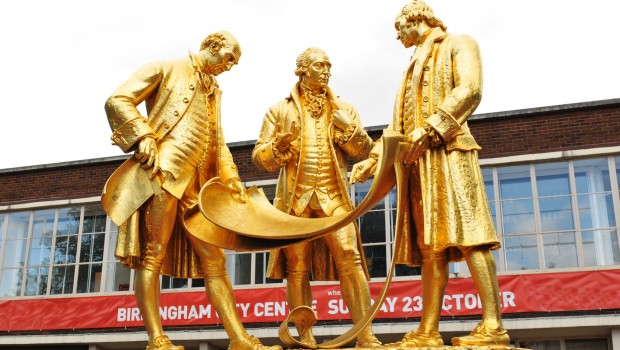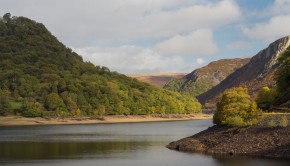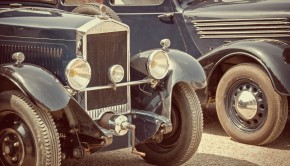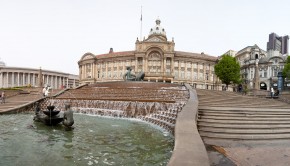Birmingham Facts – Did you know?
Hercules Cycle & Motors in Aston, Birmingham were the largest cycle manufacturers in the world by 1939, having constructed 6 million bicycles. The inspiration for Thomas the Tank Engine came from Kings Norton Station in Birmingham.
At one time Birmingham Corporation owned and developed the village of Canwell, near Tamworth, they even owned the public house now called The Bassett! All the paintings and artefacts from BMAG were stored in Elford Hall in Elford near Tamworth during the second world war. The hall and surrounding land and many houses were bequeathed to Birmingham in the 30s.
The first commemorative statue in this country to Admiral Nelson was erected in the old Birmingham Bull Ring Centre.
The first electric kettle to be fitted with a totally immersed heating element, thereby doubling its efficiency, was made by Bulpitt and Sons Ltd., Birmingham, in 1921 The company later adopted the brand name, Swan.
John Wright, of Birmingham, England, discovered that potassium cyanide was a suitable electrolyte for gold and silver electroplating, he first showed that items could be electroplated by immersing them in a tank of silver held in solution, through which an electric current was passed.”
Cadbury’s were the first chocolate manufacturer’s to put pictures on chocolate boxes, in 1861 Richard Cadbury created the first known heart-shaped candy box for Valentine’s Day.
One of the best known glass makers in the world in the 19th century was the Birmingham firm of F & C Osler, founded in 1807.
Osler made the giant crystal fountain, over eight metres high containing four tons of crystal, for the 1851 Great Exhibition in Hyde Park.
Birmingham means home (ham) of the people of Beormingas (people of Beroma).
There have been a 144 recorded different ways of spelling Birmingham.
The population of Birmingham today is nearly 1 million people.
Birmingham people are known as Brummies and the city is known as Brum or Brumagem
The first safe grenade was the Mills Bomb, an infantry issue hand grenade developed by William Mills of Birmingham in 1915.
Joseph Lucas of Birmingham made what was probably the first rechargeable accumulator powered cycle lamp in February 1888.
Fredrick Lanchester and his brother built the first petrol car in Birmingham in 1896, a single cylinder 5hp internal combustion engine with chain drive. He also invented the accelerator pedal, detachable wire wheels, stamped steel pistons, piston rings, hollow connecting rods, the torsional vibration damper, and the harmonic balancer.
Baskerville typeface, which was the first clear typeface, is still used by printers
throughout the world and is named after its inventor John Baskerville, who lived and is buried in Birmingham.
The first pneumatic tyre factory in the world was Dunlop’s in Birmingham
The X-ray was invented in Birmingham.
After electricity was discovered no one could find a use for it! Two Birmingham brothers found a use for it that changed Birmingham and the world, they patented electroplating. Their names were Elkington.
Brylcreem was invented in Birmingham in 1929 by County Chemicals who also manufactured the abrasive cleaner, ‘Chemico’. County Chemicals are still in business in Shirley.
Birmingham manufacturer Henry Clay patented the making of papier mache which was originally cloth and glue. Many durable objects such as furniture were made from papier mache.
During the American Civil War Birmingham exported 733,403 guns to America.
In 1876 Nettlefold & Chamberlain had 2000 machines in their factory producing half a million screws every week.
In 1872 D.F. Tayler & Co had 60 pin making machines making 12 million pins per day.
Birmingham company, Horsfall & Batchelor, made the first transatlantic telephone cable in 1865. While it was being laid the end was lost, so they made
another one in 1866!
In 1900 the BSA was making 2500 rifles per week.
By 1914 Birmingham was supplying the world with 28 million pen knibs per week.
In Birmingham in 1849 the first building to be put up solely for the exhibition of manufactured goods was built for an exhibition of the British Society. It had a 10,000 square feet area, and together with Bingley House, in the gardens of which it was erected, 12,800 square feet of exhibition space was available.
There are the remains of a Roman fort (Metchley) close to the Queen Elizabeth Hospital in Selly Oak
Ryknield Street, a Roman road, ran from Kings Norton to Sutton Coldfield (through Sutton Park) and onto Wall, the present day A38 roughly follows its line.
Cotton wool was invented in Birmingham.
Sir Edmund Crane, the co- founder and managing director of Hercules Cycles, is said to have pioneered the British export trade
James Webster patented Aluminum in 1881 and opened the first aluminum factory in Solihull Lodge in 1887.
Birmingham’s Jewellery Quarter employs around 6,000 people in the jewellery and related metal trades and is still the main center for gold-jewellery production in the UK, at its peak it employed more than 50,000 people. One third of all Jewellery made in the UK is made in Birmingham.
Baking powder and eggless custard powder were invented in Birmingham by
Alfred Bird.
The first manufacturer of the Robertson’s Jam Golly badge was R.E.V. Gomm, who are still making badges in Birmingham today.
John Cadbury began in business in 1924 selling tea & coffee in a shop in Bull Street, next to his parents drapery shop. He started making chocolate in his own factory in Bridge Street in 1831.
If all the pallets in Cadbury’s Minworth storage warehouse were lined up they would stretch from Birmingham to Nottingham.
Birmingham toolmaker Joseph Hudson invented the football referees whistles which was first used in a game held at Nottingham Forest in 1878. Hudson also made the first Policeman’s whistle. .Hudson’s also produced all the whistles used on the Titanic’s lifeboats, some of which have been recovered from the wreck site. One of those whistles was used by Kate Winslett in the film Titanic. It is estimated that around a 1000 million whistles have been made in the Jewellery Quarter since 1870. Hudsons are still in business making whistles today in the Jewellery Quarter.
During the war the Spitfire and Hurricane fighter were built in Birmingham as were the Lancaster & Stirling bomber. The Castle Bromwich factory of Morris Motors built more Spitfires during the war than all other UK factories combined.
Tolkien, the author of “The Lord of the Rings” and “The Hobbit” grew up near Sarehole Mill.
Matthew Boulton established his first business at Sarehole Mill in Birmingham.
Birmingham was the first UK city to have a motorway route into its centre. (A38M)
The first railway to be opened after the Liverpool to Manchester railway was the London Birmingham railway, the engineer was George Stephenson.
The traffic lights at the junction at Salford Bridge had the most complicated light sequence in the world when it was opened and delegates even came from Russia to see it. It is now totally re-modeled and below Spaghetti Junction.
One scheme suggested for the rebuilding of New Street station in the 60s was to have a heliport on the roof.
British European Airways once operated a regular helicopter shuttle service from Hay Mills park to Elmdon Airport.
In 1940 the BSA factory in Small Heath suffered a direct hit from a German bomb, 53 people, mostly night shift workers, were killed but the council has always declined to erect any sort of monument.
BSA manufactured half of all the armanants used during the Second World War.
The City of Birmingham was said to have been partly destroyed by German bombing during the war but completely destroyed by council concrete re-development in the sixties!
Prince Charles once described the Birmingham Library as a building which looked more suitable for burning books
than reading them!
The first performances of both Elgar’s Dream of Gerontius and Walton’s Belshazzar’s Feast were held in the Birmingham Town Hall.
The Birmingham town Hall was designed by John Hansom who designed the Hansom Cab.
Samson Lloyd in partnership with John Taylor a button maker, opened one of the first banks in Birmingham in 1765, it was known as Lloyds Bank.
The famous ODEON chain of cinemas was first opened in Birmingham in 1930 by Oscar Deutsch, the son of a Birmingham metal dealer. Deutsch lived in Augustus Road, Edgbaston.
Michael Balcon was born in Birmingham and founded Gainsborough Pictures, his first actor was an unknown called Alfred Hitchcock.
Birmingham still has more mileage of canals than any other city in the world including Venice.
In 1878 Joseph Lucas invented his famous King of the Road bicycle lamp. Because so many were stolen he then introduced The Lucas Missing Lamp Scheme. A £5 reward was offered for the successful conviction of the thief!
Hercules, in Aston, were the largest bicycle manufacturers in the world when bicycle manufacture was at its peak.
In 1907 in Birmingham a number of button makers came together to form the company Buttons Ltd., it became the
largest button manufacturer in the world.
Mr Rolls and Mr Royce first met in a Birmingham hotel. (this may have been Manchester in fact ! )
Birmingham’s assay office, established in 1773, is the largest and busiest in the world, testing between 40,000 and 80,000 items per day.
Birmingham is further from the sea than any other UK city but the assay mark for jewellery made in Birmingham is the anchor.
Birmingham at one time was the brass bedstead making centre of the world.
In the jewelery quarter the workshop floor was often sold separately from the premises because of the accumulated gold dust. Sometimes the complete floors would be replaced, the new owner still being in profit from the reclaimed gold!
In 1899, even though railways are firmly established, the Birmingham Canal Navigation carries 8.5 million tons of cargo per year, 20% of Britains total.
The game of lawn tennis was first originated and played in Edgbaston in 1865.
There are 30 other Birmingham’s around the world and one crater on the moon called Birmingham.
The last public hanging in Britain took place at Snow Hill, Birmingham in 1806.
In 1877 Frederick Wolsey took out the first patent for sheep shearing machine. The Wolsey sheep Shearing Machine Company was set up in Birmingham in
1889.The company later began making cars.
The Wolsey Sheep Shearing Machine Company made the turbine blades for the first jet engine designed by Frank Whittle.
There are suburbs in Birmingham called California, Hollywood and Broadway.
The Birmingham gun industry came about because of the decline in the use of swords. Birmingham was a major manufacturer of swords, supplying around 15,000 for Oliver Cromwells army..
Birmingham was responsible for bringing cheaper jewellery to the masses with advances made in electroplating in the Jewelery quarter.
In Victorian times Birmingham was known as the pen shop of the world due to its large pen making industry. Birmingham also pioneered cheap mass production of pen nibs, at its peak supplying around 1,500 million nibs per year.
The Birmingham company of Thomas Fattorini in Hockley designed the FA cup and is still in business and continues to make the Lonsdale & Commonwealth boxing belts.
Plastic, or more correctly Celluloid, was invented in Birmingham by Alexander Parkes, while he was working at Elkingtons and initially called Parkesine.
In July 1924 Birmingham held a street procession and civic reception for the Norton & New Imperial motor cycle companies, who between them had won 4 TT races.
The Balti Indian curry dish was first introduced in Birmingham in the 70s and has spawned a multitude of Balti restaurants throughout the UK.
Glass containing lime was first made in Birmingham.
Smethwick has never been part of Birmingham but many Smethwick companies shewed their addresses as Smethwick, Birmingham.
A sandstone ridge runs directly across Birmingham from the south west to the north east and roughly follows the line of the present A38.










